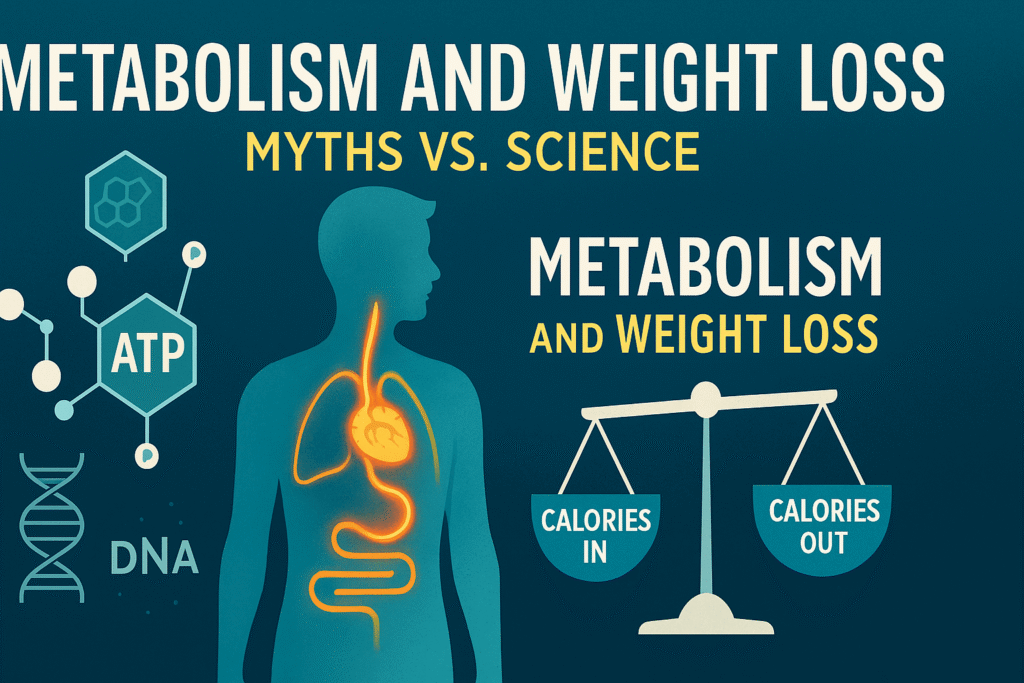For decades, “slow metabolism” has been the universal explanation for stubborn weight gain. It’s an appealing idea—blaming biology instead of behavior. But does a sluggish metabolism really exist? And if so, how much does it matter compared to diet, movement, and lifestyle? Let’s separate the myths from what science actually shows.

What Is Metabolism, Really?
Metabolism is not a single switch you can “speed up” or “slow down.” It’s the sum of all chemical reactions that convert food into energy. In practice, when people talk about metabolism, they mean total daily energy expenditure (TDEE). This is made up of:
- Basal Metabolic Rate (BMR): Energy your body burns at rest to maintain vital functions. Typically 60–70% of daily calories.
- Thermic Effect of Food (TEF): Energy used to digest and process food. Roughly 10%.
- Activity Thermogenesis: Includes both exercise and “NEAT” (non-exercise activity thermogenesis, like fidgeting, walking, standing). This can range from 15–30% depending on lifestyle.
👉 So when someone says “my metabolism is slow,” they’re usually referring to differences in BMR or in how active they are.
Myth 1: Some People Burn Almost Nothing at Rest
Reality: Variation in resting metabolic rate is smaller than most think.
- Research shows that for most adults, BMR only differs by about 200–300 kcal/day between individuals of the same age, sex, and body size.
- Yes, larger bodies burn more energy, not less, because maintaining mass requires fuel.
The real difference between people is usually in activity and food choices, not mysterious metabolic gaps.
Myth 2: Age Inevitably Destroys Metabolism
It’s true that metabolism declines with age, but the picture is nuanced.
- Large-scale studies (Pontzer et al., Science 2021) found BMR remains remarkably stable from age 20 to 60. The biggest drop happens after 60, not before.
- What changes earlier is muscle mass and activity. Less movement + gradual muscle loss = fewer calories burned, which looks like a slower metabolism.
👉 Maintaining muscle through resistance training is the single best way to buffer metabolic decline.
Myth 3: Crash Dieting “Breaks” Your Metabolism
Extreme dieting does reduce calorie expenditure, but not permanently.
- This effect is called adaptive thermogenesis: your body conserves energy during calorie restriction.
- Example: During “The Biggest Loser” study, contestants experienced large drops in metabolic rate. But later analysis showed most of that was explained by loss of body mass, not permanent metabolic damage.
👉 In most cases, when people regain lost weight, metabolism scales back up. The real challenge is sustaining weight loss behaviors long-term.
Myth 4: Eating Small Meals Frequently Boosts Metabolism
TEF (thermic effect of food) depends on what and how much you eat, not meal frequency.
- Five small meals vs. two large meals of the same calories = same TEF.
- What matters is protein intake: protein has a TEF of ~20–30%, compared to 5–10% for carbs and 0–3% for fats.
👉 Translation: A higher-protein diet increases calorie burn slightly, but grazing all day doesn’t.
The Science of “Metabolic Boosting” Foods and Habits
Some lifestyle factors can meaningfully impact energy expenditure:
- Muscle mass: Muscle is more metabolically active than fat tissue (though not dramatically: ~13 kcal/kg/day vs ~4 kcal/kg/day). Building 2–3 kg of muscle can add ~100 kcal/day—small, but significant over months.
- NEAT (Non-Exercise Activity): Subconscious movement—standing, walking, fidgeting—can vary by up to 2,000 kcal/day between individuals. This is often the hidden driver of weight loss plateaus.
- Caffeine and green tea: Slightly increase energy expenditure (~3–4%). Helpful, but not a miracle.
- Sleep and stress: Sleep deprivation raises cortisol, increasing hunger and altering glucose metabolism. Stress itself doesn’t burn calories, but it can push behaviors (overeating, inactivity) that make weight control harder.
How to Leverage Metabolism for Weight Loss
- Build and preserve muscle → Resistance training 2–3x per week is non-negotiable.
- Prioritize NEAT → Take stairs, walk after meals, stand instead of sit. Tiny actions compound into hundreds of calories.
- Optimize protein → 20–30 g per meal helps satiety and increases TEF.
- Sleep 7–9 hours → Rested bodies regulate hunger hormones better.
- Manage stress → Meditation, breathing, or even social connection reduces stress-driven eating.
Key Takeaway
Metabolism is not magic—it’s math shaped by biology, lifestyle, and environment. Instead of fearing a “slow metabolism,” focus on controllable levers: build muscle, move more throughout the day, sleep deeply, and eat strategically. Weight loss doesn’t come from hacks—it comes from aligning habits with how the body’s energy systems truly work.

Michael Carter is a registered dietitian and nutrition coach who loves making healthy eating simple and enjoyable. With more than a decade of experience, he focuses on realistic strategies for weight loss and balanced nutrition. Michael’s mission is to help people discover that good food can also taste great.

